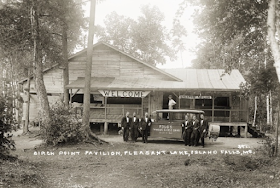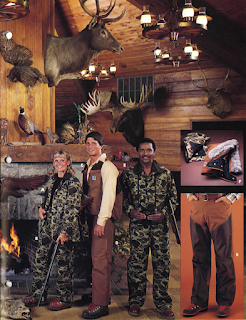Recently connected with the Resident Archivist at
Carhartt, Inc., Dave Moore, who has been tasked with creating their physical archive from the materials at hand - as well as setting an agenda for collections and processes.
Many 10e readers share my fascination with this storied brand and its place in the workwear canon. I have noted before that Carhartt seemed a little late-to-the-party to formally organize an archive, so very interested to hear what is happening now and any academic principals that guided their decisions. Part 1 of this interview is below, presented without editorial comment. Part 2 toward the end of the week.
************************
10E: Can you talk about the collection policy at Carhartt; are you involved in the search for items for the archive at all? Do you look for gaps in the collection and make suggestions? Is enough ever "enough"?
DM: Yes, I am involved in the search for acquisitions. We are still very much in the phase of growing our archive, especially our garment collection. Generally, the focus is twofold: 1) the oldest possible versions of our most iconic garments, and 2) particularly unique pieces, such as clothing we produce only for a limited number of years. We are fortunate to have employees (both current and retired) and consumers that have a deep commitment to the brand and make donations to help preserve our history. We love to find a pristine version of an iconic style, but often the garments with the most interesting stories are ones that have seen years, or often decades, of hard work.
This pair of hickory stripe overalls had a brown duck backing for its nail apron,
and was only produced for about six years in the late ‘50s early ‘60s.
10E: What are a few of your favorite items from the archive?
DM: Carhartt’s Ranch Wear line in the ‘60s was popular for its brown duck offerings, but I have a particular affinity for this denim version of the Ranch Coat. One unique aspect is the orange stitching, which really makes it pop.
Carhartt “cut its teeth” in hunting wear in the ‘30s with the Super Dux line. I love the timeless style of the “Big Game Stag Coat” in Mackinaw wool.
And it is hard to beat the iconic heart shaped buttons from Carhartt’s early years in the late 1800s early 1900s. An updated version of this chore coat is still in our line today.
10E: The Carhartt font of the 60s was v modern, almost space age... how did that come about?
DM: All the way up to the early 1960s, Carhartt stuck with a script style although our logo type face changed, you can still see this style used quite a bit on current products. We had an experimental phase in ’65-’66, when Carhartt went to lowercase block lettering surrounded by an elongated C. The logo and type face we use today was actually implemented all the way back in ‘67. We changed the font a few times since then, but eventually came around full circle to the one from the late ‘60s.
10E: Could you talk about your career path to archivist/historian?
DM: Honestly, without my knowing it at the time, I think my career path began when my dad first sat me down to watch Raiders of the Lost Ark. His interest in history really sparked mine, and I also had some absolutely amazing teachers along the way. After so many years of doing research and writing history, I developed an interest in the other side of the coin; how did all these primary source materials get here? Who saved them and organized them? Those questions ended up driving my grad studies, and I worked in both frontline museum jobs and interned at archives while I went to school.
As far as the corporate archive world goes, I am a big admirer of Ted Ryan [historian/archivist for Coca-Cola Corp. - ed]. He has done and continues to do amazing work publicizing the history of his brand.
10E: Wonder if you have 'archived' the website carhartt.com over time or if you rely on the waybackmachine.
DM: We have not yet delved into any web archiving here. I still rely primarily on our price lists and print catalogs for information on historical product offerings, although we have made huge progress in digitizing this material. We have also developed our own database in the archive for vintage product descriptions, which allows me to filter by year, fabric type, garment type, product number, etc. This database has been a major boon, especially for research and the development of garment histories for our key products.
10E: Several other retailers, notably Levi's and LLBean, have really grasped the significance of a corporate archive for materials. I believe it goes beyond the recent "heritage trend" of the last 10 years. Can you talk about some archival / business victories you have seen in your time there so far?
DM: Well, the big motivation for the creation of the archive here was the company’s 125th anniversary in 2014. The historical content was here it had been used before for many purposes, as Carhartt has always been a company to draw on its brand heritage. But it needed to be organized and made more accessible, and in just two years we’ve made huge strides. From the archive side, the overall (pun intended) victory has really been solidifying the details of our brand history. For instance, we always knew our founder, Hamilton Carhartt, started his business in a small Detroit loft, but until recent newspaper research we didn’t know where that loft was, now we do. We had vintage catalogs, but few real world historic photos of workers wearing Carhartt. Now we do.
This is the oldest known photograph of a worker wearing Carhartt (Ship Creek, AK, circa 1915).
Each new discovery puts another piece in the puzzle. From the business side, our 2016 marketing campaign (which talks about how “Our Future is in Our Heritage”) has been extremely successful and is the product of a cross-collaboration between the archive and many other departments. Through the recreation of iconic vintage pieces, we’ve been able to create a snapshot of the company’s history from 1889 that really captures our core mission and values, which are still rooted in the beliefs of Hamilton.
10E: Could you touch on the archival principle of 'reuse'? Does the business side of the operation see those economies?
DM: My firm belief, especially with regard to a company with a long history like Carhartt, is that every time you publicize that history, you are growing trust in your brand. We have an amazing design department that never ceases to innovate and create new products. The thing about Carhartt is that even when we introduce a completely new product line, there are 127 years of sweat, blood, and tears behind it. When new products are developed, it’s done in a way that harkens back to our company founder, Hamilton Carhartt, who frequently conducted face-to-face conversations with his target consumer (railroad workers) and developed an overall that addressed their specific needs. That strategy is still integral to how we operate today. Repurposing archival assets for marketing purposes puts that message across directly to the consumer;
you can trust us, we’ve done this before.
Come back later this week for Inside the Carhartt Archive - Part 2



















